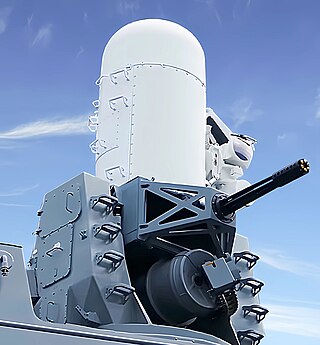
The Phalanx CIWS is a gun-based close-in weapon system to defend military watercraft automatically against incoming threats such as aircraft, missiles, and small boats. It was designed and manufactured by the General Dynamics Corporation, Pomona Division, later a part of Raytheon. Consisting of a radar-guided 20 mm (0.8 in) Vulcan cannon mounted on a swiveling base, the Phalanx has been used by the United States Navy and the naval forces of 15 other countries. The US Navy deploys it on every class of surface combat ship, except the Zumwalt-class destroyer and San Antonio-class amphibious transport dock. Other users include the British Royal Navy, the Royal Australian Navy, the Royal New Zealand Navy, the Royal Canadian Navy and the US Coast Guard.
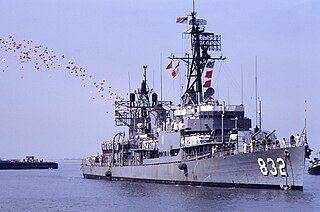
The Gearing class was a series of 98 destroyers built for the U.S. Navy during and shortly after World War II. The Gearing design was a minor modification of the Allen M. Sumner class, whereby the hull was lengthened by 14 ft (4.3 m) at amidships, which resulted in more fuel storage space and increased the operating range.

The Halifax-class frigate, also referred to as the City class, is a class of multi-role patrol frigates that have served the Royal Canadian Navy since 1992. The class is the outcome of the Canadian Patrol Frigate Project, which dates to the mid-1970s. HMCS Halifax was the first of an eventual twelve Canadian-designed and Canadian-built vessels which combine traditional anti-submarine capabilities with systems to deal with surface and air threats as well. All ships of the class are named after a major city in each province plus the cities of Ottawa and Montreal.

The Fletcher class was a class of destroyers built by the United States during World War II. The class was designed in 1939, as a result of dissatisfaction with the earlier destroyer leader types of the Porter and Somers classes. Some went on to serve during the Korean War and into the Vietnam War.

The Algerine-class minesweeper was a large group of minesweepers built for the Royal Navy (RN) and the Royal Canadian Navy (RCN) during the Second World War. 110 ships of the class were launched between 1942 and 1944.

The OTO Melara 76 mm gun is a naval gun built and designed by the Italian defence company OTO Melara. It is based on the OTO Melara 76/62C and evolved toward 76/62 SR and 76/62 Strales.

The Gridley-class destroyers were a class of four 1500-ton destroyers in the United States Navy. They were part of a series of USN destroyers limited to 1,500 tons standard displacement by the London Naval Treaty and built in the 1930s. The first two ships were laid down on 3 June 1935 and commissioned in 1937. The second two were laid down in March 1936 and commissioned in 1938. Based on the preceding Mahan-class destroyers with somewhat different machinery, they had the same hull but had only a single stack and mounted sixteen 21 inch (533 mm) torpedo tubes, an increase of four. To compensate for the increased torpedo armament weight, the gun armament was slightly reduced from five 5"/38 caliber guns (127 mm) to four. USS Maury (DD-401) made the highest trial speed ever recorded for a United States Navy destroyer, 42.8 knots. All four ships served extensively in World War II, notably in the Solomon Islands and the Battle of the Philippine Sea, with Maury receiving a Presidential Unit Citation.

The Somers-class destroyer was a class of five 1850-ton United States Navy destroyers based on the Porter class. They were answers to the large destroyers that the Japanese navy was building at the time, and were initially intended to be flotilla leaders. They were laid down from 1935–1936 and commissioned from 1937–1939. They were built to round-out the thirteen destroyers of 1,850 tons standard displacement allowed by the tonnage limits of the London Naval Treaty, and were originally intended to be repeat Porters. However, new high-pressure, high-temperature boilers became available, allowing the use of a single stack. This combined with weight savings allowed an increase from two quadruple center-line torpedo tube mounts to three. However, the Somers class were still over-weight and top-heavy. This was the first US destroyer class to use 600 psi (4,100 kPa) steam superheated to 850 °F (454 °C), which became standard for US warships built in the late 1930s and World War II.
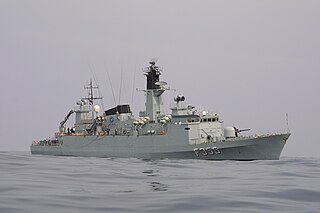
HDMS Olfert Fischer (F355) was a Niels Juel-class corvette of the Kongelige Danske Marine. The vessel was laid down in December 1978 and commissioned in October 1981. The corvette operated in the Persian Gulf on two occasions, first in 1990 and 1991 as part of the multinational fleet enforcing the United Nations sanctions against Iraq, then again in 2003 in support of the United States-led invasion of Iraq. Olfert Fischer was deployed as part of the NATO Standing Naval Force Atlantic on at least four occasions during her career.

The Royal Saudi Navy or Royal Saudi Naval Forces, is the maritime arm of the Saudi Arabian Armed Forces and one of the five service branches of the Ministry of Defense of Saudi Arabia. Its primary role is monitoring and defending the Saudi territorial waters against military or economic intrusion, and participating in international naval alliances.

The 3"/50 caliber gun in United States naval gun terminology indicates the gun fired a projectile 3 inches (76 mm) in diameter, and the barrel was 50 calibers long. Different guns of this caliber were used by the U.S. Navy and U.S. Coast Guard from 1900 through to 1990 on a variety of combatant and transport ship classes.

The Impavido class were the second group of destroyers built for the Italian Navy after World War II and the first Italian guided missile destroyers. Similar in performance to the US Navy's Charles F. Adams class, these ships were essentially improved Impetuoso-class vessels, with the after gun-turret being replaced by a Tartar surface-to-air-missile launcher and associated radar.
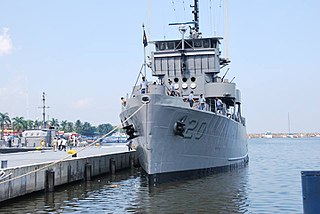
BRP Magat Salamat (PS-20) is one of several Miguel Malvar class of patrol corvettes in service with the Philippine Navy. She was originally built as USS Gayety (AM-239), an Admirable-class minesweeper with a similar hull to the PCE-842-class patrol craft produced during World War II. In 1962 she was transferred to South Vietnam for service in the Republic of Vietnam Navy as RVNS Chi Lang II (HQ-08). She was acquired by the Philippine Navy in April 1976 and later on commissioned as Magat Salamat. Along with other ex-World War II veteran ships of the Philippine Navy, she is considered one of the oldest active fighting ships in the world today.

The BRP Apolinario Mabini (PS-36) is the second ship of the Jacinto-class corvettes currently assigned to the Offshore Combat Force of the Philippine Fleet. She is one of few ships in the Philippine Navy equipped with modern systems after the completion of combat, navigation and weapon systems upgrade of her class in August 2019. She is named after Apolinario Mabini, a hero of the Philippine revolution and a former prime minister. She was originally called HMS Plover (P240) during her service with the Royal Navy.

HMS Mermaid was a Modified Black Swan-class sloop of the Royal Navy. Mermaid saw service as a convoy escort during the Second World War, taking part in the sinking of two German submarines while escorting Arctic convoys to and from the Soviet Union.

Tapi-class corvettes are a class of two corvettes that were built for the Royal Thai Navy in the early 1970s. Both ships remain in service.
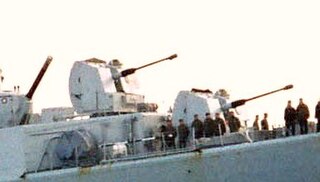
The 76mm/L62 Allargato is a single barrel, medium caliber, dual purpose automatic naval cannon designed and produced in the 1960s by the Italian defence firm of OTO-Melara as the cannon armament for all medium and large warships built for the Italian Navy in that decade. Currently, the gun remains in service with Italy's Cassiopea-class patrol vessels but has otherwise been largely replaced by the Otobreda 76 mm series of cannons.

The Ehrensköld class was the first "modern" class of destroyer built by the Swedish Navy after the First World War. It introduced several new features, mainly heavy armament in three 12 cm guns and the new 53 cm torpedo. The class included two vessels, Ehrensköld and Nordenskjöld, which were both launched in 1926 and entered service in 1927. They patrolled the Baltic Sea until 1963, after which they became target vessels. Nordenskjöld was scrapped in 1964 and Ehrensköld in 1974.

Bayandor is a corvette of the Islamic Republic of Iran Navy named after Gholamali Bayandor, and the lead ship of her class. Launched in 1963 and commissioned into the Southern Fleet in 1964, Bayandor was transferred to Iran by the United States under the Mutual Assistance Program.



















